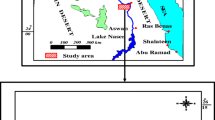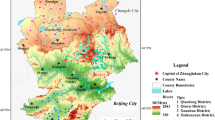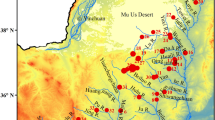Abstract
Groundwater in the Geum River basin is a major agricultural and domestic water resource. In the present study, we collected 128 groundwater samples from four candidate regions (KS, KJ, NS, and BO) for hydrochemical analyses to identify large-scale groundwater distribution. Only 5.5% of samples showed natural background levels of NO3-N and Cl, whereas about 65% of samples reflected the influence of external pollutants according to drinking water standards. Levels of tritium (3H) in groundwater in the BO region indicated rapid recharge over a uniform time span (2.88 ± 0.43 TU). The hydrochemical properties of water samples collected in this study suggest a sustainable water supply in the Geum River basin.







Similar content being viewed by others
References
IPCC (Intergovernmental Panel on Climate Change) (2014) Jimenez, B.E., T. Oki, N.W. Arnell, G. Benito, J.G. Conley, P. Döll, T Jiang, and S.S. Mwakalila. Freshwater resources. In: Climate Change 2014: Impacts, Adaptation and Vulnerability. Contribution of Working Group II to the Fifth Assessment Report of the Intergovernmental Panel on Climate Change. Field, C.B., V.R. Barros, D.J. Dokken, K.J. Mach, M.D. Mastrandrea, T.E. Bilir, M. Chatterjee, K.L. Ebi, Y.O. Estrada, R.C. Genova, B. Girma, E.S. Kissel, A.N. Levy, S. MacCracken, P.R. Mastrandrea, and L.L.White (eds.) Cambridge University Press, Cambridge, United Kingdom and New York, NY, USA.
Payus C, Huey LA, Adnan F, Rimba AB, Mohan G, Chapagain SK, Gasparatos A, Roder G, Fukushi K (2020) Impact of extreme drought climate on water security in North Borneo: case study of Sabah. Water 12(4):1135
Bates BC, Kundzewicz ZWW, Wu S, Palutikof JP (2008) Linking climate change and water resources: impacts and responses. IPCC Secretariat, Geneva
Foster S, Ait-Kadi M (2012) Integrated water resources management (IWRM): how does groundwater fit in? Hydrogeol J 20(3):415–418
van Geldern R, Baier A, Subert HL, Kowol S, Balk L, Barth JA (2014) Pleistocene paleo-groundwater as a pristine fresh water resource in southern Germany–evidence from stable and radiogenic isotopes. Sci Total Environ 496:107–115
ME (Ministry of Environment) and K-water (2019) Groundwater annual report 2019. Sejong, Daejeon
MOLIT (Ministry of Land, Infrastructure and Transport) (2017) National Groundwater Management Plan (2017~2026). Sejong
KMA (Korea Meteorological Administration), Climate information in weather. https://www.weather.go.kr/weather/climate/past_cal.jsp. Accessed 15 Dec 2020
Lee CM, Hamm SY, Cheong JY, Kim K, Yoon H, Kim M, Kim J (2020) Contribution of nitrate-nitrogen concentration in groundwater to stream water in an agricultural head watershed. Environmental Research 109313
Hem JD (1985) Study and interpretation of the chemical characteristics of natural water (Vol. 2254). Department of the Interior, US Geological Survey, Reston
Madison RJ, Brunett JO (1985) Overview of the occurrences of nitrate in groundwater of the United States. In: National Water Summary 1984: Hydrologic Events, Selected Water-Quality Trends, and Ground-Water Resources. United States Geological Survey Water Supply Paper 2275, p 93–105
Bouchard DC, Williams MK, Surampalli RY (1992) Nitrate contamination of groundwater: sources and potential health effects. J Am Water Works Ass 84(9):85–90
Wakida FT, Lerner DN (2005) Non-agricultural sources of groundwater nitrate: a review and case study. Water Res 39(1):3–16
WHO (World Health Organization) (2017) Guidelines for drinking-water quality. Fourth edition incorporating the first addendum. http://apps.who.int/iris/bitstream/10665/254637/1/9789241549950-eng.pdf?ua=1. Accessed 15 Dec 2020
ME (Ministry of Environment) (2020) Drinking Water Management Act. https://law.go.kr/LSW/engLsSc.do?menuId=0&query=&subMenu=5#AJAX. Accessed 15 Dec 2020
Gooch BF (2015) U.S. public health service recommendation for fluoride concentration in drinking water for the prevention of dental caries. Public Health Reports 130(4):318–331
Fetter CW (2018) Applied hydrogeology. Waveland Press, Long Grove
Clark ID, Fritz P (1999) Environmental isotopes in hydrology. Lewis Publishers, New York, pp 179–186
Kazemi GA, Lehr JH, Perrochet P (2006) Groundwater age. Wiley, New Jersey, pp 84–92
MOLIT (Ministry of land, infrastructure, and transport) and NGII (National geographic information institute) (2018) The National Atlas of Korea, Volume II: Natural environment and land. Jinhan M&B, Seoul, p 244
Lee KS, Lee CB (1999) Oxygen and hydrogen isotopic composition of precipitation and river waters in South Korea. J Geol Soc Korea 35:73–84 (in Korean with English abstract)
Craig H (1961) Isotopic variations in meteoric waters. Science 133:1702–1703
Yoon Y, Lee K, Ko K (2010) Development and validation of Ni–Ni electrolytic enrichment method for tritium determination in samples of underground waters of Jeju Island. J Radioanal Nucl Chem 286(2):591–595
K-water (2015) Basic groundwater survey, groundwater map production, and management guidelines. Ministry of Land, Infrastructure and Transport and K-water, Daejeon, p 163
Lloyd JW, Heathcote JAA (1985) Natural inorganic hydrochemistry in relation to ground water. Clarendon Press, Oxford
GIMS (National Groundwater Information Management and Service Center), Statistics in Groundwater in Korea. http://www.gims.go.kr/en/gims_start.do. Accessed 15 Dec 2020
Choi BY, Yun ST, Kim KH, Kim JW, Kim HM, Koh YK (2014) Hydrogeochemical interpretation of South Korean groundwater monitoring data using self-organizing maps. J Geochem Explor 137:73–84
KOSIS (Korean Statistical Information Service) (2019) Resident Registration Population. Daejeon
LH (Korea Land and Housing Corporation) (2019) The Present Status of Urban Planning. Jinju
Rao NR, Rao N, Rao KSP, Schuiling RD (1993) Fluorine distribution in waters of Nalgonda district, Andhra Pradesh, India. Environ Geol 21(1–2):84–89
Hwang J (2001) Fluorine distribution and attenuation of groundwater within limestone and granite from Keumsan–Wanju fluorite mineralized zone. Econ Environ Geol 34(1):105–117
Cho BW, Lee BD, Yoon W, Im HC (2003) Study on the possibility of seawater intrusion in the Ulsan area using Br: Cl weight ratios of groundwater. Econ Environ Geol 36(5):339–347
Park SC, Yun ST, Chae GT, Yoo IS, Shin KS, Heo CH, Lee SK (2005) Regional hydrochemical study on salinization of coastal aquifers, western coastal area of South Korea. J Hydrol 313:182–194
Yoon W, Ji SJ, So CS (2003) The hydrochemical and stable isotope characteristics of shallow groundwater near the Gwangju stream. Econ Environ Geol 36(6):441–455
Mullaney JR, Lorenz DL, Arntson AD (2009) Chloride in groundwater and surface water in areas underlain by the glacial aquifer system, northern United States (vol. 5086). US Geological Survey, Reston
Gerritse RG, George RJ (1988) The role of soil organic matter in the geochemical cycling of chloride and bromide. J Hydrol 101(1–4):83–95
Taylor SJ, Kelly WR, Panno SV, Weck R, Zheng W, Zhang Y, Liu WT (2014) Karst groundwater contaminants in western illinois: comparison of current conditions with historical data. Illinois Natural History Survey, Prairie Research Institute, University of Illinois, Champaign, p 53
Kim KH, Yun ST, Kim HK, Kim JW (2015) Determination of natural backgrounds and thresholds of nitrate in South Korean groundwater using model-based statistical approaches. J Geochem Explor 148:196–205
Panno SV, Hackley KC, Hwang HH, Greenberg SE, Krapac IG, Landsberger S, O’kelly DJ, (2006) Characterization and identification of Na-Cl sources in ground water. Groundwater 44(2):176–187
Han D, Currell MJ (2018) Delineating multiple salinization processes in a coastal plain aquifer, northern China: hydrochemical and isotopic evidence. Hydrol Earth Syst Sci 22:3473–3491
Re V, Sacchi E (2017) Tackling the salinity-pollution nexus in coastal aquifers from arid regions using nitrate and boron isotopes. Environ Sci Pollut Res 24(15):13247–13261
Koh DC, Chae GT (2008) Estimation of mixing properties and mean residence time using 3H for groundwater in typical geothermal and CO2-rich areas in South Korea. J Geol Soc Korea 44(4):507–522
Jung YY, Koh DC, Yoon YY, Kwon HI, Heo J, Ha K, Yun ST (2019) Using stable isotopes and tritium to delineate groundwater flow systems and their relationship to streams in the Geum River basin, Korea. J Hydrol 573:267–280
Acknowledgements
This work was supported by the Basic Research Project (21-3411) of the Korea Institute of Geoscience and Mineral Resources (KIGAM), funded by the Ministry of Science and Information and Communications Technology. We thank the other members of the Groundwater Research Center at KIGAM for their help with system setup and operation, data acquisition, and sample analyses. We also thank Dr. Min Han at the Geological Research Center at KIGAM for his considered advice regarding the geology of the study site.
Author information
Authors and Affiliations
Corresponding author
Additional information
Publisher's Note
Springer Nature remains neutral with regard to jurisdictional claims in published maps and institutional affiliations.
Appendix
Appendix
Rights and permissions
About this article
Cite this article
Choi, H., Lee, CM., Koh, D.C. et al. Recharge and spatial distribution of groundwater hydrochemistry in the Geum River basin, South Korea. J Radioanal Nucl Chem 330, 397–412 (2021). https://doi.org/10.1007/s10967-021-07807-8
Received:
Accepted:
Published:
Issue Date:
DOI: https://doi.org/10.1007/s10967-021-07807-8





